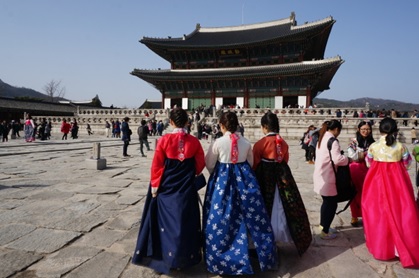Exploring South Korea's Unique Housing: An Exhibition Unveiled

Table of Contents
A Glimpse into Traditional Hanok Architecture
South Korea's traditional houses, known as Hanoks, represent a sophisticated blend of architecture and philosophy. Understanding Hanoks is crucial to appreciating the evolution of South Korea's unique housing.
Defining Features of Hanoks
Hanoks stand apart due to their distinctive features:
- Natural Materials: The construction primarily utilizes natural materials like wood, paper (Hanji), and stone, creating a harmonious connection with the environment. This emphasis on natural materials contributes to the unique aesthetic and environmental sustainability of Hanoks.
- Ondol Underfloor Heating: The ingenious Ondol system, a floor heating system, provides warmth in the often-cold Korean winters. This innovative heating solution is a defining characteristic of Hanok design and contributes to its energy efficiency.
- Harmony with Nature and Feng Shui: Hanok design principles emphasize harmony with nature and incorporate Feng Shui principles to optimize energy flow and create a balanced living space. The orientation of the house and the placement of elements within are carefully considered.
- Unique Spatial Layouts and Design Elements: Hanoks feature open floor plans and flexible spaces that adapt to various needs. Traditional elements like the 'maru' (open veranda) and 'anbang' (main room) showcase the unique spatial design of these homes.
- Preserved Hanoks and Modern Adaptations: Many Hanoks have been beautifully preserved, offering a glimpse into Korea's rich architectural heritage. Furthermore, innovative architects are adapting Hanok design principles to create modern, sustainable homes. Bukchon Hanok Village in Seoul stands as a prime example of preserved Hanok architecture.
The Hanok's Influence on Modern Design
The timeless elegance of Hanoks continues to inspire contemporary architects.
- Modern Interpretations: Modern buildings often incorporate Hanok aesthetics, such as the use of natural materials, clean lines, and open floor plans. This fusion of tradition and modernity is a hallmark of contemporary South Korean architecture.
- Incorporation of Traditional Elements: Contemporary homes are increasingly integrating traditional elements like Hanji screens or Ondol-inspired heating systems. This subtle integration seamlessly blends the old and the new.
- Examples of Modern Buildings: Many new constructions in Seoul and other major cities integrate Hanok design principles, creating aesthetically pleasing and environmentally friendly buildings. (Include images here if available showcasing modern buildings with Hanok influences.)
- Challenges and Benefits: Blending traditional and modern styles presents challenges such as maintaining authenticity while incorporating modern amenities. However, the result is a unique architectural style that reflects Korea's rich history and its commitment to sustainable design.
Modern High-Rise Living in South Korea
South Korea's rapidly developing cities showcase impressive high-rise architecture, reflecting the country's technological prowess. This contrasts sharply with the traditional Hanoks, providing a compelling study in the evolution of South Korea's unique housing.
Architectural Styles of South Korean High-Rises
South Korean high-rises are known for:
- Functionality and Efficiency: Designs prioritize functionality and space optimization, reflecting the needs of a densely populated country. This focus on efficiency is evident in both the layout and the use of space.
- Technological Integration: Smart home features and technological integration are commonly found, showcasing South Korea's technological advancements. This is a key difference compared to the more traditional Hanoks.
- Global Architectural Influences: The architecture reflects a variety of global influences, resulting in a diverse range of styles, reflecting both Korean aesthetics and global trends.
- Iconic High-Rise Buildings: Major cities boast iconic high-rise buildings that are both functional and visually striking, showcasing South Korea's architectural achievements on a global scale. Examples might include the Lotte World Tower or the Samsung headquarters.
- Sustainable Design Practices: An increasing emphasis is placed on sustainable design practices in high-rise construction, such as energy-efficient materials and green building technologies.
Challenges and Opportunities in High-Density Living
High-rise living presents both challenges and opportunities:
- Space Optimization: Clever design solutions are crucial for maximizing space in high-rise apartments. This includes innovative furniture and built-in storage solutions.
- Community Building: Creating a sense of community in high-rise buildings is vital. Building amenities and community events contribute to a positive living experience.
- Natural Light and Ventilation: Maximizing natural light and ventilation is crucial for the well-being of residents. Architectural designs often incorporate large windows and efficient ventilation systems.
- Environmental Impact: Addressing the environmental impact of high-rise construction is increasingly important. Sustainable materials and energy-efficient designs play a key role.
The Exhibition: Showcasing South Korea's Housing Diversity
The recent exhibition offered a comprehensive overview of South Korea's unique housing.
Key Exhibits and Displays
The exhibition featured:
- Architectural Models and Displays: Detailed models and displays showcased various architectural styles, from Hanoks to modern high-rises. These provided a visual representation of the evolution of South Korean housing.
- Innovative Design Solutions: The exhibition highlighted innovative design solutions and technological advancements in both traditional and modern housing.
- History and Evolution: The exhibition provided insights into the history and evolution of South Korean housing, from its traditional roots to its modern expressions.
- Interactive Elements: Interactive elements and engaging presentations enhanced the visitor experience, making the exhibition both educational and entertaining.
Visitor Experience and Educational Opportunities
The exhibition provided:
- Educational Value: The exhibition provided a valuable educational experience, raising awareness of South Korea's rich architectural heritage and its modern innovations.
- Workshops and Lectures: (If applicable, mention any workshops, lectures, or related events held alongside the exhibition.)
- Impact and Reception: (If possible, include information on the exhibition's impact and reception from visitors and critics.)
- Visitor Quotes: (Include visitor quotes or reviews, if available, to enhance the credibility and engagement of the article.)
Conclusion
South Korea's unique housing, from the elegant simplicity of Hanoks to the towering heights of modern high-rises, showcases a fascinating blend of tradition and innovation. The exhibition provided a captivating glimpse into this diverse architectural landscape, highlighting both the historical roots and the forward-thinking designs that shape South Korean homes. By exploring the different facets of South Korea's unique housing, we gain a deeper appreciation for the country's rich culture and its commitment to architectural excellence. To learn more about the innovative and historical aspects of South Korean residential architecture, explore further resources on the exhibition and related architectural styles. Continue exploring the fascinating world of South Korea's unique housing!

Featured Posts
-
 Lotto Jackpot Saturday April 12th Winning Numbers
May 02, 2025
Lotto Jackpot Saturday April 12th Winning Numbers
May 02, 2025 -
 Brtanwy Wzyr Aezm Kw Kshmyr Ke Msyle Pr Dstawyz Pysh Ky Gyy
May 02, 2025
Brtanwy Wzyr Aezm Kw Kshmyr Ke Msyle Pr Dstawyz Pysh Ky Gyy
May 02, 2025 -
 1000 Days Later Popular Fortnite Skins Re Enter The Item Shop
May 02, 2025
1000 Days Later Popular Fortnite Skins Re Enter The Item Shop
May 02, 2025 -
 Fortnites Unexpected Downtime Chapter 6 Season 2 Launch Postponed Indefinitely
May 02, 2025
Fortnites Unexpected Downtime Chapter 6 Season 2 Launch Postponed Indefinitely
May 02, 2025 -
 Vertraagde Tbs Zorg De Gevaren Van Lange Wachttijden
May 02, 2025
Vertraagde Tbs Zorg De Gevaren Van Lange Wachttijden
May 02, 2025
Latest Posts
-
 Saudi Arabias Abs Market Transformation A Change Bigger Than Spain
May 03, 2025
Saudi Arabias Abs Market Transformation A Change Bigger Than Spain
May 03, 2025 -
 India Us Tensions Rise Justice Vs De Escalation
May 03, 2025
India Us Tensions Rise Justice Vs De Escalation
May 03, 2025 -
 India Rejects De Escalation Call Demands Justice
May 03, 2025
India Rejects De Escalation Call Demands Justice
May 03, 2025 -
 Rubio Seeks De Escalation As India Reasserts Demand For Justice
May 03, 2025
Rubio Seeks De Escalation As India Reasserts Demand For Justice
May 03, 2025 -
 Post Tragedy Analysis A Review Of Alec Baldwins Film Rust
May 03, 2025
Post Tragedy Analysis A Review Of Alec Baldwins Film Rust
May 03, 2025
